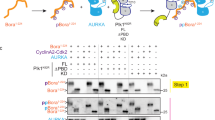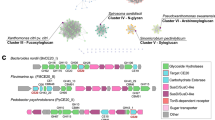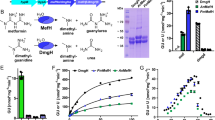Abstract
The catalytic activity of many protein kinases is controlled by conformational changes of a conserved Asp-Phe-Gly (DFG) motif. We used an infrared probe to track the DFG motif of the mitotic kinase Aurora A (AurA) and found that allosteric activation by the spindle-associated protein Tpx2 involves an equilibrium shift toward the active DFG-in state. Förster resonance energy transfer experiments show that the activation loop undergoes a nanometer-scale movement that is tightly coupled to the DFG equilibrium. Tpx2 further activates AurA by stabilizing a water-mediated allosteric network that links the C-helix to the active site through an unusual polar residue in the regulatory spine. The polar spine residue and water network of AurA are essential for phosphorylation-driven activation, but an alternative form of the water network found in related kinases can support Tpx2-driven activation, suggesting that variations in the water-mediated hydrogen bond network mediate regulatory diversification in protein kinases.
This is a preview of subscription content, access via your institution
Access options
Access Nature and 54 other Nature Portfolio journals
Get Nature+, our best-value online-access subscription
$32.99 / 30 days
cancel any time
Subscribe to this journal
Receive 12 print issues and online access
$259.00 per year
only $21.58 per issue
Buy this article
- Purchase on SpringerLink
- Instant access to full article PDF
Prices may be subject to local taxes which are calculated during checkout





Similar content being viewed by others
References
Hunter, T. Protein kinases and phosphatases: the yin and yang of protein phosphorylation and signaling. Cell 80, 225–236 (1995).
Davies, H. et al. Mutations of the BRAF gene in human cancer. Nature 417, 949–954 (2002).
Paez, J.G. et al. EGFR mutations in lung cancer: correlation with clinical response to gefitinib therapy. Science 304, 1497–1500 (2004).
Daley, G.Q., Van Etten, R.A. & Baltimore, D. Induction of chronic myelogenous leukemia in mice by the P210bcr/abl gene of the Philadelphia chromosome. Science 247, 824–830 (1990).
Huse, M. & Kuriyan, J. The conformational plasticity of protein kinases. Cell 109, 275–282 (2002).
Glover, D.M., Leibowitz, M.H., McLean, D.A. & Parry, H. Mutations in aurora prevent centrosome separation leading to the formation of monopolar spindles. Cell 81, 95–105 (1995).
Zorba, A. et al. Molecular mechanism of Aurora A kinase autophosphorylation and its allosteric activation by TPX2. eLife 3, e02667 (2014).
Dodson, C.A., Yeoh, S., Haq, T. & Bayliss, R. A kinetic test characterizes kinase intramolecular and intermolecular autophosphorylation mechanisms. Sci. Signal. 6, ra54 (2013).
Seki, A., Coppinger, J.A., Jang, C.Y., Yates, J.R. & Fang, G. Bora and the kinase Aurora a cooperatively activate the kinase Plk1 and control mitotic entry. Science 320, 1655–1658 (2008).
Macůrek, L. et al. Polo-like kinase-1 is activated by aurora A to promote checkpoint recovery. Nature 455, 119–123 (2008).
Kufer, T.A. et al. Human TPX2 is required for targeting Aurora-A kinase to the spindle. J. Cell Biol. 158, 617–623 (2002).
Eyers, P.A., Erikson, E., Chen, L.G. & Maller, J.L. A novel mechanism for activation of the protein kinase Aurora A. Curr. Biol. 13, 691–697 (2003).
Toya, M., Terasawa, M., Nagata, K., Iida, Y. & Sugimoto, A. A kinase-independent role for Aurora A in the assembly of mitotic spindle microtubules in Caenorhabditis elegans embryos. Nat. Cell Biol. 13, 708–714 (2011).
Zeng, K., Bastos, R.N., Barr, F.A. & Gruneberg, U. Protein phosphatase 6 regulates mitotic spindle formation by controlling the T-loop phosphorylation state of Aurora A bound to its activator TPX2. J. Cell Biol. 191, 1315–1332 (2010).
Hammond, D. et al. Melanoma-associated mutations in protein phosphatase 6 cause chromosome instability and DNA damage owing to dysregulated Aurora-A. J. Cell Sci. 126, 3429–3440 (2013).
Gold, H.L. et al. PP6C hotspot mutations in melanoma display sensitivity to Aurora kinase inhibition. Mol. Cancer Res. 12, 433–439 (2014).
Hodis, E. et al. A landscape of driver mutations in melanoma. Cell 150, 251–263 (2012).
Kornev, A.P., Haste, N.M., Taylor, S.S. & Eyck, L.F. Surface comparison of active and inactive protein kinases identifies a conserved activation mechanism. Proc. Natl. Acad. Sci. USA 103, 17783–17788 (2006).
Kornev, A.P., Taylor, S.S. & Ten Eyck, L.F. A helix scaffold for the assembly of active protein kinases. Proc. Natl. Acad. Sci. USA 105, 14377–14382 (2008).
Hubbard, S.R., Wei, L., Ellis, L. & Hendrickson, W.A. Crystal structure of the tyrosine kinase domain of the human insulin receptor. Nature 372, 746–754 (1994).
Nagar, B. et al. Structural basis for the autoinhibition of c-Abl tyrosine kinase. Cell 112, 859–871 (2003).
Martin, M.P. et al. A novel mechanism by which small molecule inhibitors induce the DFG flip in Aurora A. ACS Chem. Biol. 7, 698–706 (2012).
Dodson, C.A. et al. Crystal structure of an Aurora-A mutant that mimics Aurora-B bound to MLN8054: insights into selectivity and drug design. Biochem. J. 427, 19–28 (2010).
Bayliss, R., Sardon, T., Vernos, I. & Conti, E. Structural basis of Aurora-A activation by TPX2 at the mitotic spindle. Mol. Cell 12, 851–862 (2003).
Nowakowski, J. et al. Structures of the cancer-related Aurora-A, FAK, and EphA2 protein kinases from nanovolume crystallography. Structure 10, 1659–1667 (2002).
Lawrence, H.R. et al. Development of o-chlorophenyl substituted pyrimidines as exceptionally potent aurora kinase inhibitors. J. Med. Chem. 55, 7392–7416 (2012).
Dodson, C.A. & Bayliss, R. Activation of Aurora-A kinase by protein partner binding and phosphorylation are independent and synergistic. J. Biol. Chem. 287, 1150–1157 (2012).
Anderson, K. et al. Binding of TPX2 to Aurora A alters substrate and inhibitor interactions. Biochemistry 46, 10287–10295 (2007).
Levinson, N.M. & Boxer, S.G. A conserved water-mediated hydrogen bond network defines bosutinib's kinase selectivity. Nat. Chem. Biol. 10, 127–132 (2014).
Fafarman, A.T., Webb, L.J., Chuang, J.I. & Boxer, S.G. Site-specific conversion of cysteine thiols into thiocyanate creates an IR probe for electric fields in proteins. J. Am. Chem. Soc. 128, 13356–13357 (2006).
Suydam, I.T. & Boxer, S.G. Vibrational Stark effects calibrate the sensitivity of vibrational probes for electric fields in proteins. Biochemistry 42, 12050–12055 (2003).
Suydam, I.T., Snow, C.D., Pande, V.S. & Boxer, S.G. Electric fields at the active site of an enzyme: direct comparison of experiment with theory. Science 313, 200–204 (2006).
Fafarman, A.T., Sigala, P.A., Herschlag, D. & Boxer, S.G. Decomposition of vibrational shifts of nitriles into electrostatic and hydrogen-bonding effects. J. Am. Chem. Soc. 132, 12811–12813 (2010).
Choi, J.H., Oh, K.I., Lee, H., Lee, C. & Cho, M. Nitrile and thiocyanate IR probes: quantum chemistry calculation studies and multivariate least-square fitting analysis. J. Chem. Phys. 128, 134506 (2008).
Burgess, S.G. et al. Allosteric inhibition of Aurora-A kinase by a synthetic vNAR domain. Open Biol. 6, 160089 (2016).
Heron, N.M. et al. SAR and inhibitor complex structure determination of a novel class of potent and specific Aurora kinase inhibitors. Bioorg. Med. Chem. Lett. 16, 1320–1323 (2006).
Wu, J.M. et al. Aurora kinase inhibitors reveal mechanisms of HURP in nucleation of centrosomal and kinetochore microtubules. Proc. Natl. Acad. Sci. USA 110, E1779–E1787 (2013).
Levinson, N.M. et al. A Src-like inactive conformation in the abl tyrosine kinase domain. PLoS Biol. 4, e144 (2006).
Carrera, A.C., Alexandrov, K. & Roberts, T.M. The conserved lysine of the catalytic domain of protein kinases is actively involved in the phosphotransfer reaction and not required for anchoring ATP. Proc. Natl. Acad. Sci. USA 90, 442–446 (1993).
Meharena, H.S. et al. Deciphering the structural basis of eukaryotic protein kinase regulation. PLoS Biol. 11, e1001680 (2013).
Azam, M., Seeliger, M.A., Gray, N.S., Kuriyan, J. & Daley, G.Q. Activation of tyrosine kinases by mutation of the gatekeeper threonine. Nat. Struct. Mol. Biol. 15, 1109–1118 (2008).
Madhusudan, A., Akamine, P., Xuong, N.H. & Taylor, S.S. Crystal structure of a transition state mimic of the catalytic subunit of cAMP-dependent protein kinase. Nat. Struct. Biol. 9, 273–277 (2002).
Teeter, M.M. Water structure of a hydrophobic protein at atomic resolution: Pentagon rings of water molecules in crystals of crambin. Proc. Natl. Acad. Sci. USA 81, 6014–6018 (1984).
Rahman, A. & Stillinger, F.H. Hydrogen-bond patterns in liquid water. J. Am. Chem. Soc. 95, 7943–7948 (1973).
Batkin, M., Schvartz, I. & Shaltiel, S. Snapping of the carboxyl terminal tail of the catalytic subunit of PKA onto its core: characterization of the sites by mutagenesis. Biochemistry 39, 5366–5373 (2000).
Manning, G., Whyte, D.B., Martinez, R., Hunter, T. & Sudarsanam, S. The protein kinase complement of the human genome. Science 298, 1912–1934 (2002).
Unbekandt, M. et al. A novel small-molecule MRCK inhibitor blocks cancer cell invasion. Cell Commun. Signal. 12, 54 (2014).
Schindler, T. et al. Structural mechanism for STI-571 inhibition of abelson tyrosine kinase. Science 289, 1938–1942 (2000).
Sligar, S.G. & Gunsalus, I.C. A thermodynamic model of regulation: modulation of redox equilibria in camphor monoxygenase. Proc. Natl. Acad. Sci. USA 73, 1078–1082 (1976).
Kannan, N. & Neuwald, A.F. Did protein kinase regulatory mechanisms evolve through elaboration of a simple structural component? J. Mol. Biol. 351, 956–972 (2005).
Eaton, G., Pena-Nunez, A.S. & Symons, M.C.R. Solvation of cyanoalkanes [CH3CN and (CH3)3CCN]. An infrared and nuclear magnetic resonance study. J. Chem. Soc. Faraday Trans. 1 84, 2181–2193 (1988).
Dale, R.E., Eisinger, J. & Blumberg, W.E. The orientational freedom of molecular probes. The orientation factor in intramolecular energy transfer. Biophys. J. 26, 161–193 (1979).
Eastman, P. et al. OpenMM 4: A reusable, extensible, hardware independent library for high performance molecular simulation. J. Chem. Theory Comput. 9, 461–469 (2013).
Marcou, G. & Rognan, D. Optimizing fragment and scaffold docking by use of molecular interaction fingerprints. J. Chem. Inf. Model. 47, 195–207 (2007).
McGibbon, R.T. et al. MDTraj: A modern open library for the analysis of molecular dynamics trajectories. Biophys. J. 109, 1528–1532 (2015).
Lindorff-Larsen, K. et al. Improved side-chain torsion potentials for the Amber ff99SB protein force field. Proteins 78, 1950–1958. http://dx.doi.org/10.1002/prot.22711 (2010).
Meagher, K.L., Redman, L.T. & Carlson, H.A. Development of polyphosphate parameters for use with the AMBER force field. J. Comput. Chem. 24, 1016–1025 (2003).
Humphrey, W., Dalke, A. & Schulten, K. VMD: visual molecular dynamics. J. Mol. Graph. 14, 33–38 (1996).
Chodera, J.D., Swope, W.C., Pitera, J.W., Seok, C. & Dill, K.A. Use of the weighted histogram analysis method for the analysis of simulated and parallel tempering simulations. J. Chem. Theory Comput. 3, 26–41 (2007).
Shirts, M.R. & Chodera, J.D. Statistically optimal analysis of samples from multiple equilibrium states. J. Chem. Phys. 129, 124105 (2008).
Acknowledgements
We thank E. Conti (Max Planck Institute of Biochemistry, Martinsried) for providing the DNA construct encoding WT human AurA. We thank R. Frontiera for helpful discussions and advice on fitting infrared spectra, and J. Muretta for many fruitful discussions and advice on fluorescence spectroscopy. We thank T. Freedman and W. Gordon for helpful discussions and critical reading of the manuscript. This work was funded in part by grants from the National Institutes of Health (R00 GM102288, N.M.L.). J.D.C. acknowledges support from the Sloan Kettering Institute and NIH grant P30 CA008748. The authors are grateful to the Folding@home donors who participated in this project.
Author information
Authors and Affiliations
Contributions
N.M.L. conceived and designed the project. S.C. performed the kinase activity assays and thermal shift assays, and S.C. and N.M.L. performed the infrared spectroscopy experiments. E.F.R. performed the fluorescence experiments. J.D.C., and J.M.B. conceived and performed the molecular dynamics simulations and analysis. N.M.L. and J.D.C. wrote the manuscript.
Corresponding author
Ethics declarations
Competing interests
J.D.C. is a member of the Scientific Advisory Board for Schrödinger, LLC.
Supplementary information
Supplementary Text and Figures
Supplementary Results and Supplementary Figures 1–9. (PDF 808 kb)
Rights and permissions
About this article
Cite this article
Cyphers, S., Ruff, E., Behr, J. et al. A water-mediated allosteric network governs activation of Aurora kinase A. Nat Chem Biol 13, 402–408 (2017). https://doi.org/10.1038/nchembio.2296
Received:
Accepted:
Published:
Issue date:
DOI: https://doi.org/10.1038/nchembio.2296
This article is cited by
-
CEP192 localises mitotic Aurora-A activity by priming its interaction with TPX2
The EMBO Journal (2024)
-
Allostery governs Cdk2 activation and differential recognition of CDK inhibitors
Nature Chemical Biology (2021)
-
Trends in kinase drug discovery: targets, indications and inhibitor design
Nature Reviews Drug Discovery (2021)
-
Bora phosphorylation substitutes in trans for T-loop phosphorylation in Aurora A to promote mitotic entry
Nature Communications (2021)
-
Hyper-activation of Aurora kinase a-polo-like kinase 1-FOXM1 axis promotes chronic myeloid leukemia resistance to tyrosine kinase inhibitors
Journal of Experimental & Clinical Cancer Research (2019)



